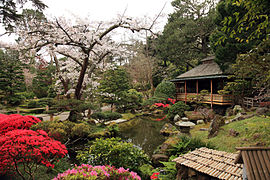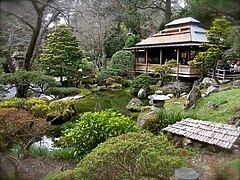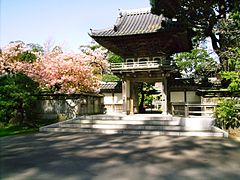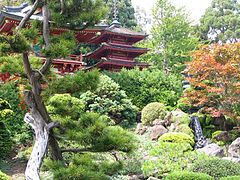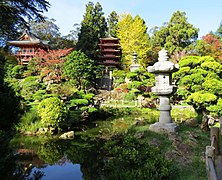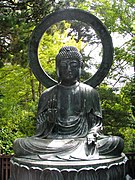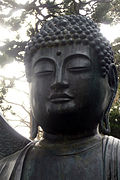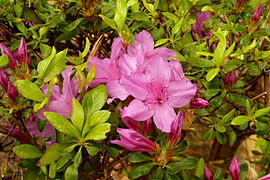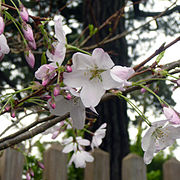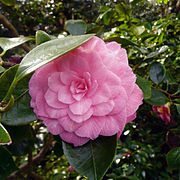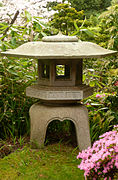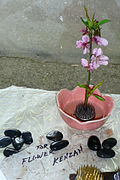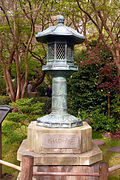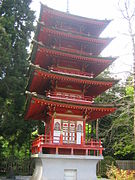Japanese Tea Garden (San Francisco)
The Japanese Tea Garden (Japanese: 日本茶園) in San Francisco, California, is a popular feature of Golden Gate Park, originally built as part of a sprawling World's Fair, the California Midwinter International Exposition of 1894. Though many of its attractions are still a part of the garden today, there have been changes throughout the history of the garden that have shaped it into what it is today.
For other places with the same name, see Japanese Tea Garden (disambiguation).Japanese Tea Garden
The oldest public Japanese garden in the United States, this complex of many paths, ponds and a teahouse features plants and trees pruned and arranged in a Japanese style. The garden's 3 acres contain sculptures and structures influenced by Buddhist and Shinto religious beliefs, as well as many elements of water and rocks to create a calming landscape designed to slow people down.
The Japanese Tea Garden is now one of the three locations of the Gardens of Golden Gate Park, along with the San Francisco Botanical Garden and the Conservatory of Flowers. [1]
Significant features[edit]
The Tea House[edit]
The Tea House has been a part of the Japanese Tea Garden since its creation at the Mid-winter Fair in 1894, though it has been rebuilt several times.[6][7][8] In a description of the garden published in 1950, at a time when it was "dubbed the Oriental Tea Garden" the author, Katherine Wilson, states that "further along from the Wishing Bridge was the thatched teahouse, where for three generations the women of the Hagiwara family, in their gaily, flowered kimonos, served tea and rice cakes."[9] Within Japanese Culture, the connection between the serenity of nature and the drinking of tea comes from a sacred tradition, the Japanese Tea Ceremony. The origin of the tea ceremony dates back to 1203 AD, "with Buddhist priests of the Zen sect, who found the infusion [tea] useful in keeping them awake during midnight devotions."[10] As it developed, the ceremony eventually earned the name Chanoyu, which, in literal translation means "hot water for tea." Today, the heart of the tradition is the elegant making and pouring of whipped green tea, also called Matcha. When the "ceremony is well executed, an unspoken and perhaps inexpressible Zen quality lingers in the air."[11] As Tea Ceremonies became more widespread, they eventually became associated with the presence or nature, more specifically with the presence of a garden. Over time, the tea house became "the transcendent viewing place for contemplating the landscape" in a traditional tea garden.[11]
Physical design elements[edit]
Trees[edit]
The trees of the Japanese Tea Garden have more than a century-long history. The garden consists of a variety of trees, including flowering cherry trees, azaleas, magnolias, camellias, Japanese maples, pines, cedars and cypresses.[19] The dwarf trees were planted by the Hagiwara family in the years following the Midwinter Exposition of 1894.[20] However, when Japanese-Americans were thrown into internment camps in 1942, the dwarf trees left with the Hagiwara family. These trees were then sold to Dr. Hugh and Audrey Fraser, who in her will, entrusted the trees back to the Japanese Tea Garden. Samuel Newsom, an expert on Japanese Gardens and Japanese trees, redesigned the dwarf trees in 1965 after the dwarf trees returned to the garden.[21] Newsom designed the dwarf trees onto the hillside, next to the waterfall, and, in 1966 planted more below the Temple Gate. Most of these dwarf trees originated in Japan, brought over by the Hagiwara family. The oldest tree was a Japanese black pine, which is now on a bamboo frame next to the Tea House.[22] In 2005, the San Francisco Parks Trust and the San Francisco Recreation and Park Development repaired additional landscape and recognized the history of the trees via plaques.[23]
Today, the Monterey pine trees are among the more labor-intensive in the garden, according to previous landscape supervisor of Golden Gate Park, Ed Schuster. Every three years, the pines are layered into zig-zagged planes, creating an artistic design favored in traditional Japanese landscapes. These pines average sixty feet tall, so city arborists use ropes to climb to the tops and take great care pruning each tree.[24][25][26]
Water[edit]
Water commonly plays a large role in Japanese gardens and serves to highlight purity and liveliness. Ponds and waterfalls are often placed with precise orientations with respect to the sun to determine the reflection.[27] In the native Japanese religion, ponds were created for sacred reasons as places for the gods to roam while the surrounding stones were utilized as seats.[28] The auditory atmosphere of the Japanese Tea Garden is created through the blissful and peaceful sound of the moving water.[29] Tsukubai, found in the Japanese Tea Garden, is a water basin originally used by guests to purify themselves before taking part in the tea ceremony.[30] The dry garden at the Japanese Tea Garden represents the importance of water through wave patterns and artificial islands created by rocks.[31] Water has remained an integral representation of Japanese Gardens and its connection to the elite world of immortals.[32]
Rocks[edit]
Rocks are integral components of the traditional Japanese garden. They are generally thought of as the backbone of the arrangement of the space and as "dwelling places of gods, tokens of regal power, and symbols of longevity."[32] Rocks serve three main purposes in the garden, the first of which is mimicking larger natural formations such as mountains and bodies of water.[33] The second purpose is to form rock clusters. In Japanese Gardens, rocks are often clustered with one large rock as the base stone. Others are arranged around it so they agree with the mood or order set forth by the base. Those groups of rocks often appear to have order and flow while remaining asymmetrical.[34] Thirdly, rocks can also serve the purpose of guiding the eyes to other parts of the garden. They point viewers toward the focal point of the design of the garden. Paths and stepping-stones are formed in irregular patterns so people slow down and notice the design around them.[35] In addition, Shinto is a fundamental principle in Japanese gardening where rocks have a decorative duty depending on their positions. A tall stone standing erect of the ground, for example, is associated to masculinity, while a low flat stone represents femininity, mirroring Shinto belief that all things in nature contain gender equilibrium.[36] The Japanese Tea Garden is a mixture of influential Shinto and Buddhist religious beliefs.
